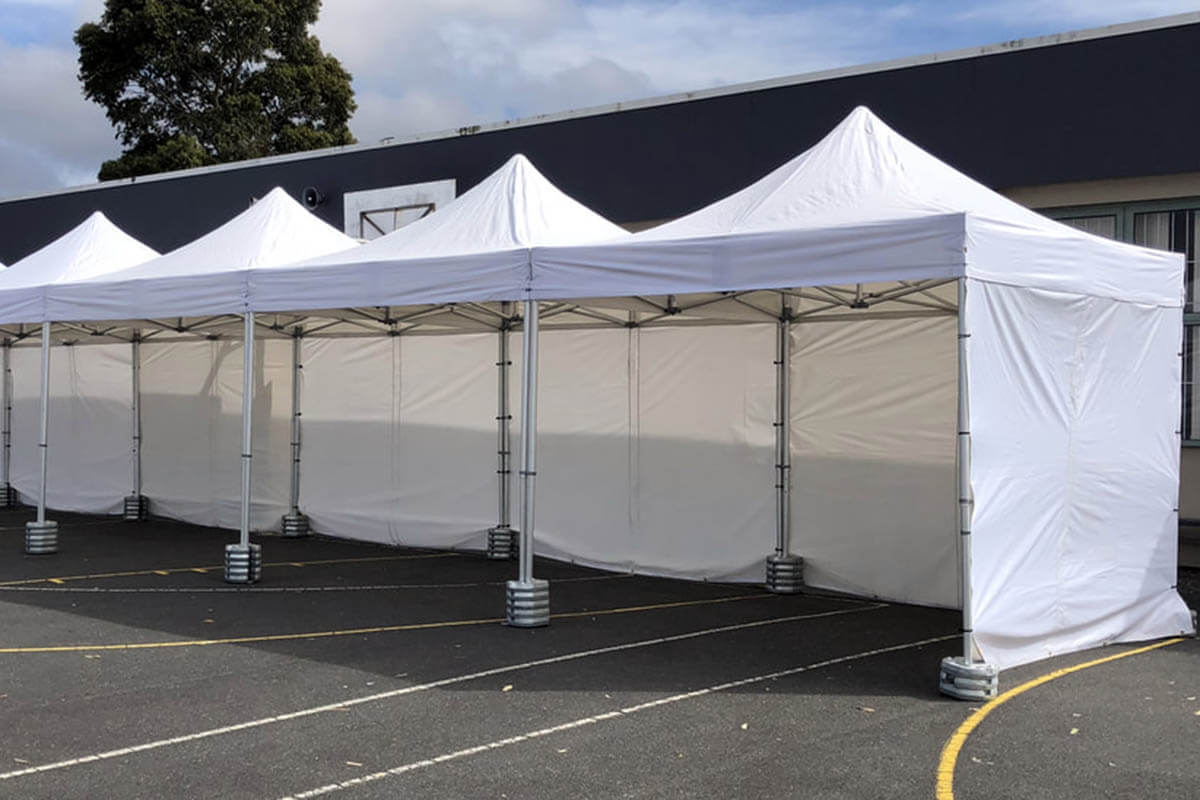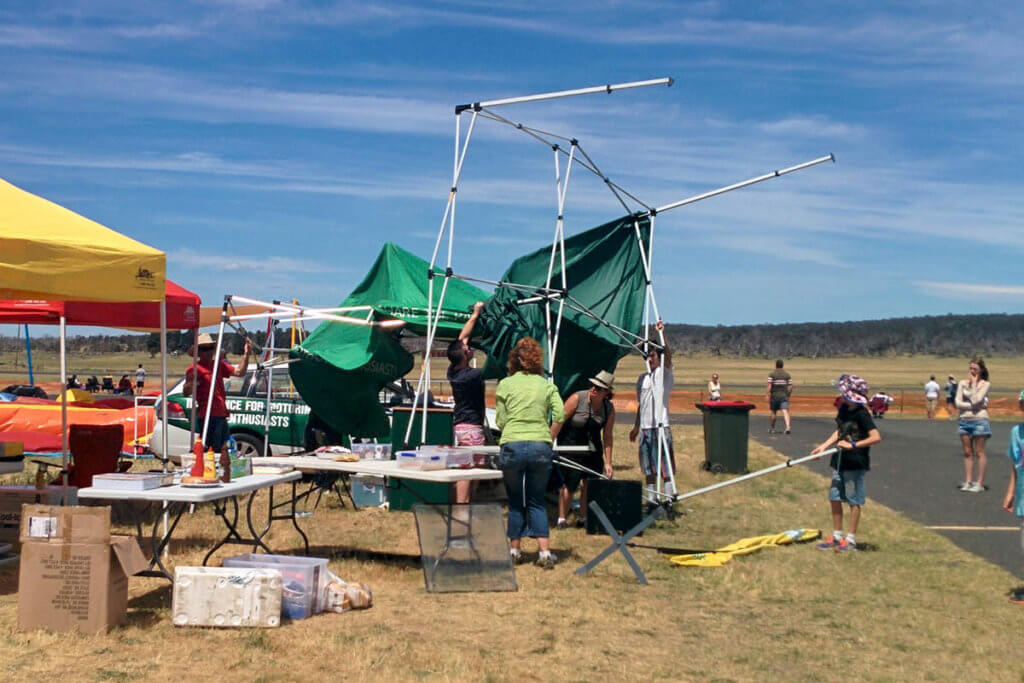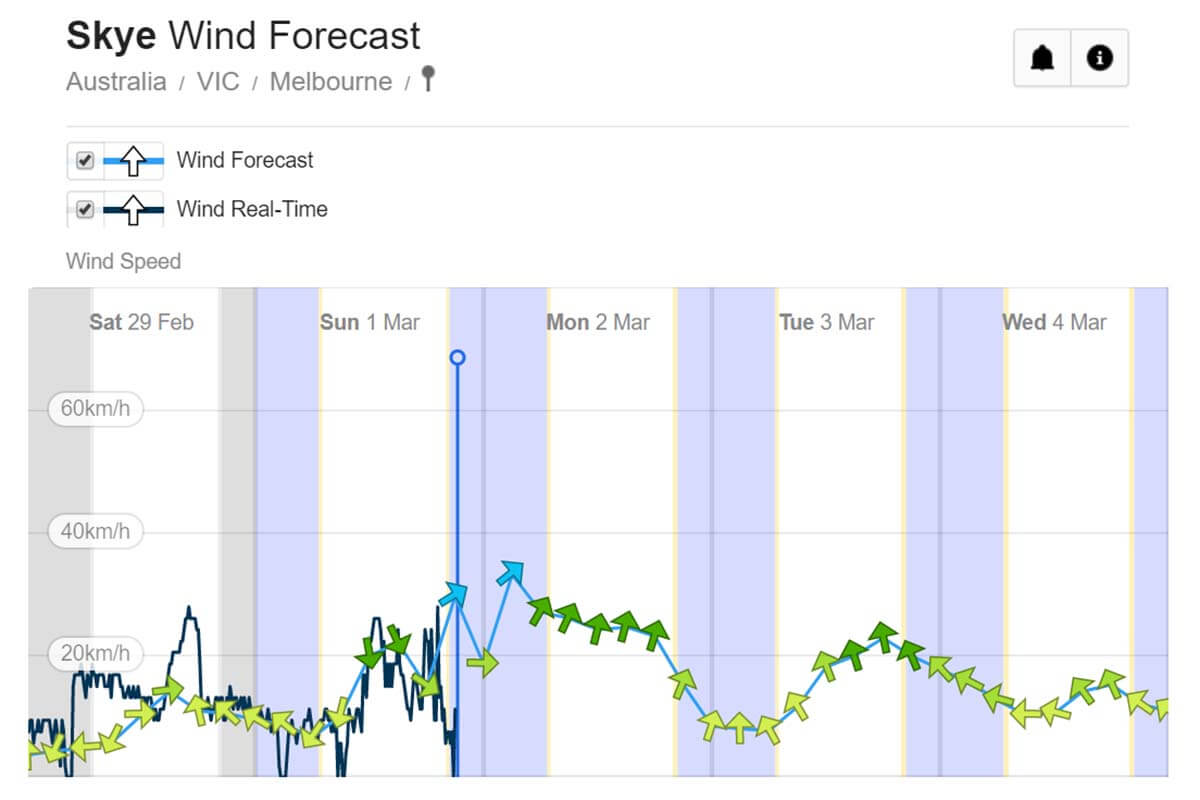
It doesn’t matter how good your marquee is, the weakest link will always be how well it’s secured to the ground.
It is imperative that a marquee is very well secured. Not only from a perspective that you want to protect your investment, but also, and more importantly, from a safety perspective.
A marquee acts like a giant parachute and is prone to both uplift and sliding forces. Accordingly, any weighting system that is used must be suitable to counteract both types of force. And there should also be no ambiguity over the systems effectiveness once installed.
We only endorse cast iron leg weights as an appropriate weighting solution. They’re ability to hold down the marquee is known, and they are also durable and easy to use.
Leg weights are the foundations of a safe set up
When you build any fixed structure, the key to it resisting weather events is having good foundations.
For example, when you build a fence, you need to concrete the posts into the ground to a specified depth. If the posts are not concreted at the right depth, or concreted well, you’ll have issues in the future when wind blows against the fence; resulting in it falling over.
A marquee is no different to any other structure in that it depends on its foundations to resist weather events. These foundations are the cast iron leg weights that are installed over the feet.
These leg weights prevent the structure from lifting and sliding in wind. If you do not use leg weights you run the risk that at any moment the marquee could become mobile and take off - putting the lives of those around the marquee at risk.

After being in this business for over 17 years now, we can confidently say that 98% or more of damage that we ever have a client come back to us about stems directly from the fact that the marquee was either:
- Not secured at all
- or, it was poorly secured (ie - pegs ripped out of the ground)
- or, it was underweighted
It is vital that you secure your marquee with the appropriate amount of leg weights to match the wind speeds you want to use your Technishelter in.
If your marquee blows away and hits someone or causes damage, you’re responsible
A marquee can be a very dangerous object if not properly secured.
Just like when driving a car, you are responsible for the damage that an accident causes. You are completely responsible for the marquee when in use - so you’re best to take the appropriate precautions to ensure that you use your marquee in a safe manner.
We often find people consider leg weights to be a secondary purchase to a marquee, but that is not indeed the case. The leg weights are effectively mandatory if you wish to use the marquee in a safe manner.
Using the Beaufort Wind Scale to understand current conditions
Typically Technishelter users don’t have an anemometer on hand when using their marquees, and therefore we often reference the Beaufort scale to customers as a visual scale to understand what the weather conditions are at the time.
The Beaufort scale relates wind speed to observed conditions at sea or on land and helps you determine the kind of wind conditions that are prevailing at that moment. Here is what the Beaufort scale looks like:
| Scale & Speed | Description | Visible Conditions |
| Beaufort 0 < 2 km/h | Calm | Smoke rises vertically. |
| Beaufort 1 2–5 km/h | Light air | Direction shown by smoke drift but not by wind vanes. |
| Beaufort 2 6–11 km/h | Light breeze | Wind felt on face; leaves rustle; wind vane moved by wind. |
| Beaufort 3 12–19 km/h | Gentle breeze | Leaves and small twigs in constant motion; light flags extended. |
| Beaufort 4 20–28 km/h | Moderate breeze | Raises dust and loose paper; small branches moved. |
| Beaufort 5 29–38 km/h | Fresh breeze | Small trees in leaf begin to sway; crested wavelets form on inland waters. |
| Beaufort 6 39–49 km/h | Strong breeze | Large branches in motion; whistling heard in telegraph wires; umbrellas used with difficulty. |
| Beaufort 7 50–61 km/h | High wind, moderate gale, near gale | Whole trees in motion; inconvenience felt when walking against the wind. |
| Beaufort 8 62–74 km/h | Gale,fresh gale | Twigs break off trees; generally impedes progress. |
| Beaufort 9 75–88 km/h | Strong/severe gale | Slight structural damage (chimney pots and slates removed). |
| Beaufort 10 89–102 km/h | Stormwhole gale | Seldom experienced inland; trees uprooted; considerable structural damage. |
| Beaufort 11 103–117 km/h | Violent storm | Very rarely experienced; accompanied by widespread damage. |
| Beaufort 12 ≥ 118 km/h | Hurricane force | Devastation. |
Source: https://en.wikipedia.org/wiki/Beaufort_scale
This scale can be used when using a Technishelter to determine what the current conditions are.
What weight is required for a particular wind speed
At a minimum, we recommend at least 15kg per leg. But it all depends on the size that you’re setting up.
The factor at play with weighting requirements are:
- Marquee size as larger marquees have more surface area for wind to act on
- If the walls are on or off
- The terrain type (ie - open, trees, etc) that the marquee is being used in
You need to use the appropriate amount of weight based on the wind speeds you expect the structure to withstand. The more wind, the more weight is required.
| Weight vs Wind | 15kg per leg | 30kg per leg | 45kg per leg | 60kg per leg | 75kg per leg | 90kg per leg |
| 2.4x2.4m | 52 | 68 | 80 | 91 | 101 | 110 |
| 3x3m | 47 | 61 | 73 | 83 | 92 | 100 |
| 3x4.5m | 43 | 56 | 66 | 75 | 83 | 90 |
| 3x6m | 33 | 43 | 52 | 59 | 65 | 71 |
| 4x4m | 40 | 52 | - | - | - | - |
| 4x8m | 28 | 44 | - | - | - | - |
The amount of wind (in km/h), including gusts, a marquee can withstand for a given amount of weighting on each of the legs
We recommend weighting for as much wind speed as you can reasonably justify. As safety is the number one priority, there is no such thing as “too much” weight that can be used.
In saying that though, there is an explicit expectation that you as the user of the Technishelter® follow a duty of care with respect to not using the product outside it’s design limits and should you expect the wind conditions to exceed the above tabulated values, you must dismantle the structure. These products are temporary shelters and have a maximum design limit - they are not indestructible. Their design allows them to be dismantled in a rapid manner and should be done so if the wind speed, including gusts, is expected to exceed the design limits of the structures.
An example of planning an outing
Firstly, we recommend before any event / show / day that you intend to use your Technishelter at, you check the weather forecast. It’s very quick these days to use apps on phones to pull up very detailed weather forecasts. Some that we recommend are:
- Windy: Wind map & weather forecast
- Bureau of Meteorology - Water and the Land: Forecast Wind
- Wind Forecast - Australia - WillyWeather
Let’s use WillyWeather as an example if we were attending a dog show at KCC Park in Melbourne. Here is the wind forecast for Skye (where KCC Park is) for the next 5 days. Consider that the wind speeds cited in forecasts are averages, and that wind gusts can be 40 per cent stronger, and stronger still in the vicinity of storms and squalls.

You can see that on Saturday Feb 29th, the maximum wind forecasted (green arrows, light blue line) was approximately 15km/h. But then you can see that there was a spike in wind (dark blue line) around mid-afternoon during the wind change where the speed indeed spiked by 40-50% more. Similarly on Sunday March 1st, when there was a forecast wind speed increase, there was an actual real wind speed decrease.
This is the key with wind - it’s totally unpredictable and forecasts are just that, forecasts. So if you see a forecast of 15km/h, actually more realistically means 30km/h including gusts, but plus a safety margin (a forecast is afterall, just a forecast) could mean maximum winds experienced to be in the range of 30-40km/h.
Determining the weights required in this example
On the Beaufort scale, using our 30-40km/h wind range (including safety buffer), this would be a scale rating of “5” which is described as being able to see “Small trees in leaf begin to sway; crested wavelets form on inland waters.”.
Now taking the above in consideration, and referring to our weighting table, this is what you’d require on each marquee size
| Size | 40km/h Winds |
| 2.4m x 2.4m | 15kg |
| 3m x 3m | 15kg |
| 3m x 4.5m | 15kg |
| 3m x 6m | 30kg |
| 4m x 4m | 15kg |
| 4m x 8m | 30kg, and near to structure limit |
Take extra care during set up and take down
One last point we’d like to touch on is that you need to be extra vigilant when setting up & taking down the marquee.
The key reason for this is that often this is the only time that users don’t weigh / secure their marquee as they need to actually consentina the frame open or closed.
In fact, the marquee should still be secured at this stage in the process but it is done via a slightly different method. We suggest to:
- Attach a rope(s) to some fixed structures / weights such that you maintain a bit of free movement, but also should the structure pick up, it will not fly away
- Keep one leg firmly secured to the ground via stacking extra weights on it, or by using pegs in the ground
- Use enough people (one person for each leg) so that the whole structure can be managed should a wind pick up
Please pay extra attention during this stage of the process.
Conclusion and Summary
Technishelter folding marquees are engineered to be extremely strong and robust units. They are designed to take a lot of wind load but regardless of their strength and durability the weakest link will be how they’re secured to the ground. They are highly susceptible to being lifted and taken away from it’s installation. For this reason, our guidelines must be followed and the unit weighted to the ground to prevent uplift and sliding.
We provide a guide as to the weights required for the different sizes for different wind speeds, and you as the user can use both online resources for weather forecasting as well as the Beaufort scale to understand the weather conditions and secure your marquee accordingly. Additionally, should the maximum wind speed of the structure be reached, Technishelter’s are easy to use and allow fast and efficient pack up in the event of inclement weather.
It is your responsibility as the user to ensure your Technishelter is installed safely. Should your marquee cause any damage to property or people, you will be liable by law for not following our instructions.
